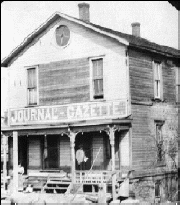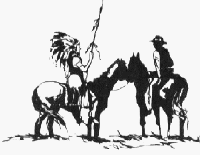Recollections of an Old Man
This article was printed in "The Sidney Journal" on
Friday, November 13, 1896. Entitled RECOLLECTIONS OF AN OLD MAN, the writer is identified
only as ‘J.M.’ The author takes us back to what life was like in Shelby County,
Ohio for its early pioneers.
"As we look back down the path of life
it seems impossible that we should have come so far. Those old landmarks and familiar
places which we knew in our boyhood days are almost covered by the mist of three-quarters
of a century.
In 1808 my father came
from Virginia to Fairfield County, Ohio. He moved all of his possessions, including a wife
and two little children, on a two wheeled cart. The roads were bad, and there were many
streams to ford. Many times tangled thickets and woods covered with a dense growth of
underbrush impeded their progress. In many places the old primeval forests had not echoed
the sound of the woodsman's ax, and the wild bird’s
song had not been disturbed for centuries. The wolf, bear and deer still roamed over the
hills and valleys undisturbed, except by the Indian hunter. Father hitched two horses to
the cart, one ahead of the other, and after many weary days and nights reached his new
home, then in the Far West, Fairfield county. Soon afterward he moved to Pickaway
county."
"In 1823, when I was 10 years old, we moved to Shelby county,
and, with seven other families, located four miles north of Sidney. We came from Pickaway
county in wagons; we were eight days on the road. I remember my first impression of
Sidney. It was made up of a few cabins just south of the Monumental Building. We ate
dinner on the day we arrived at Sidney at a log cabin standing where the JOURNAL office now stands.
 The first log houses had been built five
or six years before we came. There were a few standing across the river, which they called Dingmansburg. Upon reaching the land which
father and the neighbors who had come with us had bought, we began clearing, and in a day
or so had up our first log cabin, 18 x 20 feet. One man, who was the Vanderbilt of our
number, put up a large hewed log cabin, with a hewed log kitchen. This was the ‘brown
stone front’ of our settlement. The first log houses had been built five
or six years before we came. There were a few standing across the river, which they called Dingmansburg. Upon reaching the land which
father and the neighbors who had come with us had bought, we began clearing, and in a day
or so had up our first log cabin, 18 x 20 feet. One man, who was the Vanderbilt of our
number, put up a large hewed log cabin, with a hewed log kitchen. This was the ‘brown
stone front’ of our settlement.
The only towns near us
were Sidney and Hardin. St. Johns and Wapakoneta were two
Indian villages. St. Johns was called Blackhoof.
It was named for their old Chief. Soon after we were located in our new home in the woods
several squaws came to our house to trade. My mother was very much frightened, but before
long we found that they were peaceable and only wanted to exchange skins and wampum for
dishes, groceries or almost anything we had to trade."
"Sometimes the hunters would stop to see father. They set
their guns outside, and  made signs that they were at peace. One night, I remember, 19 Indian warriors encamped near our house. We had
two large dogs which kept watch all night. The Indians came over to borrow a large kettle
in which to boil mush for supper. They were drunk, and the next morning, when sober, they
had forgotten where they had borrowed the kettle, and took it to our neighbor. made signs that they were at peace. One night, I remember, 19 Indian warriors encamped near our house. We had
two large dogs which kept watch all night. The Indians came over to borrow a large kettle
in which to boil mush for supper. They were drunk, and the next morning, when sober, they
had forgotten where they had borrowed the kettle, and took it to our neighbor.
The forests seemed to be full of Indians.
They hunted and trapped along the streams and around the ponds and lakes. There was but
one room with a garret in our cabin. There were 12 in the family. The eight boys slept in
the garret, and we thought we had plenty of room. We thought it might be somewhat crowded
if much company should come.
The next year after we
came to Shelby county father hired Bill Richardson to clear 15 acres of woods, 18 inches
and under. I do not know whether the boys know what that means or not. It means they were
to cut down every tree 18 inches in diameter and under.
Well, Richardson brought
eight hands along, and we all ate and slept in that cabin. Mother said if there had been
many more she could hardly have taken care of them. We raised flax and made our own clothing. Father often joined teams with a neighbor,
and putting on 10 or 12 bushels of grain, they drove to Cincinnati and exchanged the grain
for salt and sole leather."
"Our first school house was erected one mile and a quarter
northeast of the Plum creek church edifice. We split puncheons and hewed them for the
floor, and the roof was made of clapboards. We cut poles, split them, cut off the
splinters and bored holes in the end, in which to drive legs. These were our benches. A
log was cut out of the north side and one out of the east for windows. The man who lived
in the ‘brown stone front’ cabin was the only one who took a newspaper; it was
the Cincinnati "Gazette." We greased one of these newspapers and pasted it over
the hole in the sides to let in light and to keep out the wind and rain.
Old Billy Wilson was our first teacher. We
had few books and little ‘larnin’ in those days. The
woods were full of deer, wolves, bears, wild turkeys and squirrel. Every year we let our
hogs run out in the woods. There were no fences, so in the late fall we had to go west for
miles and drive our hogs home. Many times they would be lost, and became wild hogs.
The warwhoop of the Indian has died away. Most of them have gone to
their happy hunting ground. The crooked paths over the hills and down through the valleys
are replaced by great highways...The scream of the Indian hunter is replaced by the shrill
whistle of the locomotive and the hum of machinery. The quiet, unbroken "old
woods" of three-quarters of a century ago has become a busy, densely populated
commonwealth."
'Pioneer' segment written in
October, 1997 by Sherrie Casad-Lodge
[ Back to Pioneer Index ] |

